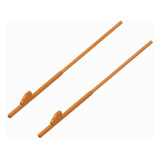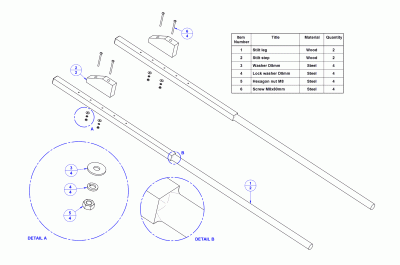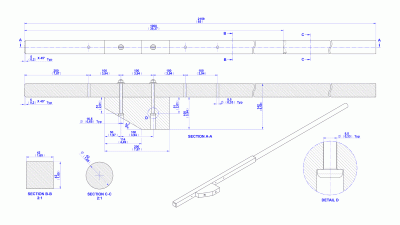With this simple woodworking project you can make a hand-held walking stilts, perfect way for kids to develop coordination and balance while having fun.
Walking Stilts are poles equipped with steps for the feet to stand on to enable the user to walk elevated above the ground. They are often used in circus, where the artists entertain the audience with their balancing skills. Sometimes are also used by house painters and fruit pickers. In the past, walking stilts have been used for crossing the swamps; also the shepherds used them to watch the cattle, because it allowed them to move quite fast and have a good view on a surrounding area from a higher position. Today, the walking stilts are favorite children toys. Walking stilts are usually made out of two long straight wooden poles, with attached footsteps on a certain height. In the nature, the wooden walking stilts can be made out of two straight, firm and long limbs that have a branch growing out at almost right angle on a suitable height. There are two basic types of walking stilts: the first type has considerably extended poles (legs) over the footsteps that should be held with hands in the upper parts. They are not tied to the legs, so it is easy to jump off if the balance is lost. They are suitable for beginners. The second type has straps with which the walking stilts are tied to the feet and do not necessarily have to be held with hands during the walk. This type is usually extended above the footsteps just to fasten the straps to the legs. This type is often used by more experienced stilt walkers.

You should adjust the height of the poles (legs) to the needs and skills of the child.
Our stilts have adjustable steps (footholds, footsteps). The lowest height of the footsteps in our plan is 35 cm, but as a child will develop skills and balance the steps can be raised 10 cm higher each time. Diameter of the legs is 42 mm, its lower part is square and the upper part – which is held in the hands – is cylindrical, to be comfortable for armpits and hands.
When choosing a wood for the wooden stilts the most important thing is that wood must be without any damage and it should be knot free. If the wood has any kind of knot, the stilts will break on that place and this can lead to fall and serious injury of a child. Choose durable straight grained hardwood like hard (sugar) maple wood, alder or ash wood.
Since the stilt legs are hold tightly with hands during the walk, it is necessary to sand these parts thoroughly to avoid injury by splinters. Later, during the use, sand any nicks or splinters regularly. Finished walking stilts should be protected with some waterproof coat such as Teak oil, Tung oil or lacquer. For the proper protection, you should apply at least three to five layers of coating. You must lightly sand the wood between each application using fine grit sandpaper. If you decide to use oil, coat them at least once a year to protect them from the moisture. Left untreated, they allow moisture to permeate the wood, which will eventually damage the stilts. To prevent splitting stilt bottoms, you can tightly wrap glass tape or band of thin metal around the bottom.


While walking on the stilts, the poles should be behind the armpits and the arms should be wrapped around the front of them. It is impossible to maintain the balance if the poles are held in front of the body. For first steps, select a firm, even surface on which to walk and try to position yourself next to a wall that you can use as support. At first, the walking stilts are real challenge, but with exercise this kind of walking becomes quite natural, even when going uphill or downhill. Stilt walking is a great fun for children. It develops their balance, coordination and endurance, but at the same time it gives self-confidence when the skill of stilt walking is successfully mastered. In the beginning, when the child is starting to learn walking on the stilts, the steps should be set on the lowest level. During this period of learning, a few falls are inevitable, so a child also needs to learn how to fall properly to avoid injury. This is why it is important for the child to jump down from the stilts on the ground easily, so in the beginning the stilts that you need to tie to the legs are not the right choice, and an additional support is needed for the hands. Due to the safety of the child, in the beginning, the child should wear helmet, elbow and knee pads; also the supervision of adults is mandatory. After a while, when a child improve stilt walking, steps should be gradually raised on a higher levels of the stilts. Only when the technique of stilt walking is mastered completely, the stilts can be tied to the feet and knees (instead of holding it in hands). The hands are now free, and the walking stilts will provide a completely new experience. Walking stilts are an ideal entertainment gadgets and the child will willingly go out on the fresh air to exercise and improve its physical skills.
Please always supervise your child when they are playing with the stilts.